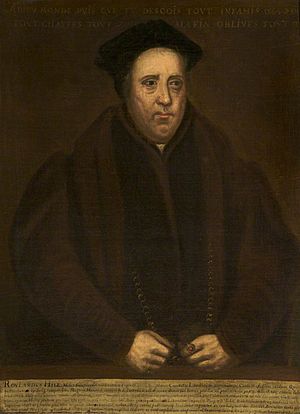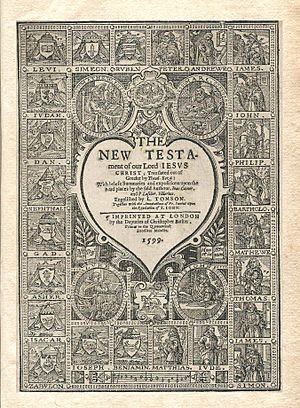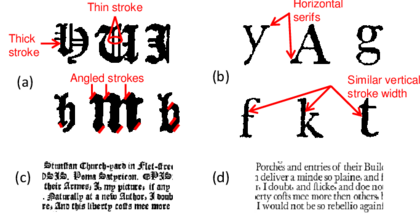Geneva Bible facts for kids
Quick facts for kids Geneva Bible |
|
|---|---|
| GenevaBible.JPG | |
| Full name: | Geneva Bible |
| Other names: | Breeches Bible |
| NT published: | 1557 |
| Complete Bible published: | 1560 |
| Derived from: | Tyndale Bible |
| Textual basis: | Textus Receptus |
| Publisher: | Sir Rowland Hill of Soulton |
| Religious affiliation: | Protestant (Reformed) |
|
Genesis 1:1-3
In the beginning God created the heaven and the earth. And the earth was without forme and voyde, and darkeness was upon the depe, and the Spirit of God moved upon the waters. Then God said, "Let there be light" and there was light. |
|
|
For God so loved the world, that he hath given his only be gotten Son, that whosoever beleveth in him, should not perish, but have everlasting life. |
|
| The Bible in English |
| Old English (pre-1066) |
| Middle English (1066-1500) |
| Early Modern English (1500-1800) |
| Modern Christian (1800-) |
| Modern Jewish (1853-) |
| Miscellaneous |
The Geneva Bible was a very important English translation of the Bible. It came out 51 years before the famous King James Version. Many English Protestants in the 1500s used it. Famous people like William Shakespeare and Oliver Cromwell read it. It was even brought to America by the Pilgrim Fathers on the Mayflower ship.
This Bible was special because it was the first one printed in large numbers for everyone to buy. It also came with many helpful study tools. These tools included notes, maps, pictures, and guides for each book of the Bible. Readers could also find cross-references to other verses. This made it much easier for people to understand the Bible on their own. The language of the Geneva Bible was strong and clear. Because of this, many readers liked it more than other Bibles of its time.
Contents
History of the Geneva Bible
The Geneva Bible came after the Great Bible of 1539. The Great Bible was the first official Bible used by the Church of England.
Why the Geneva Bible was created
During the rule of Queen Mary I of England (1553–1558), many Protestant scholars had to leave England. Queen Mary I was Catholic, and she did not support Protestants. These scholars went to Geneva, Switzerland. Geneva was a city where John Calvin and Theodore Beza were important religious leaders.
One of these scholars was William Whittingham. He led the team that translated the Geneva Bible. Other people who helped included Myles Coverdale and Christopher Goodman. Whittingham was in charge of the New Testament, which was finished in 1557. The Old Testament was overseen by Anthony Gilby.

The first full Geneva Bible, with an updated New Testament, came out in 1560. Sir Rowland Hill helped publish it. It was not printed in England until 1575 (New Testament) and 1576 (full Bible). More than 150 different versions of this Bible were printed. The last one was probably in 1644. The first Bible printed in Scotland was also a Geneva Bible in 1579. In fact, a law was passed in Scotland in 1579 that required every household to buy a copy.
Notes and King James I
The Geneva Bible had many notes in the margins. These notes explained the Bible text and were based on Calvinist and Puritan ideas. The rulers of the Church of England did not like these notes. King James I also disliked them. He thought some notes were "seditious," meaning they could cause people to rebel. He believed they went against the idea of a king's power. For example, some notes seemed to call kings "tyrants."
Because of this, King James I decided to create a new Bible translation. This new Bible would become the King James Bible. He wanted a Bible without the Geneva Bible's notes. He also wanted more control over the translation. The first King James Bibles, printed in 1611, did not have these kinds of notes.
At first, the King James Version did not sell well. It had to compete with the popular Geneva Bible. To help his version, King James later stopped new printings of the Geneva Bible. However, some printers still made Geneva Bibles. They put an older date, like 1599, on them to hide that they were printed later.
How the Geneva Bible was made
The Geneva Bible was the first English Bible translated entirely from the original languages. These languages were Hebrew, Aramaic, and Greek. The New Testament was mostly a revised version of William Tyndale's earlier work. However, Tyndale had only translated part of the Old Testament. The English scholars in Geneva finished translating the Old Testament directly from Hebrew for the first time. William Whittingham led this important work.
Text and style
The Geneva Bible used scholarly versions of the Greek New Testament and Hebrew Old Testament. It was largely based on earlier translations by William Tyndale and Myles Coverdale. But it was the first English Bible where all of the Old Testament was translated straight from Hebrew.
The Geneva Bible was also the first English Bible to use verse numbers. These numbers were based on the work of Robert Estienne. This made it much easier to find specific parts of the Bible.
The 1560 Geneva Bible was printed using Roman type. This is the style of letters we use every day. Many later editions, however, used an older style called black-letter or "Gothic" type.
Size and illustrations
The Geneva Bible was also made in sizes that were easier to carry and cheaper to buy. The 1560 Bible was a medium size. But smaller "pocket" editions were also made. Some very large editions were printed too. In the late 1500s, a Geneva New Testament might cost less than a week's pay for a worker.
The 1560 Geneva Bible included many study helps. It had woodcut pictures, maps, and helpful tables or indexes. Each book of the Bible had an introduction. Each chapter also had a list of its contents with verse numbers. Some smaller Bibles did not have pictures or notes. But some large ones had extra illustrations, like one showing Adam and Eve.
The "Breeches Bible"
The Geneva Bible got the funny nickname "Breeches Bible." This was because of how it translated a specific verse in Genesis. In Genesis Chapter 3, Verse 7, the Bible describes Adam and Eve making clothes. The Geneva Bible says they "made themselves breeches."
Earlier English Bibles, like Tyndale's and the Great Bible, used the word "aprons" instead. When the King James Version came out in 1611, it also changed "breeches" back to "aprons."
Here is how different Bibles translated Genesis 3:7:
Tyndale Bible
|
Geneva Bible
|
King James Bible
|
Legacy of the Geneva Bible
Even though the King James Version was meant to replace the Geneva Bible, the King James translators used the Geneva Bible a lot. Some experts believe that about 20% of the King James Version came directly from the Geneva Bible. The Geneva Bible had a huge impact on Protestantism in Britain and America. It helped create a strong Protestant faith that shaped culture in both places.
Many people think the Pilgrim Fathers brought the King James Bible to North America on the Mayflower in 1620. But they actually brought copies of the Geneva Bible.
Modern versions
In 2006, a company called Tolle Lege Press released a version of the 1599 Geneva Bible with modern spelling. They kept the original cross-references and study notes. They also added a glossary to explain older English words.
See also




